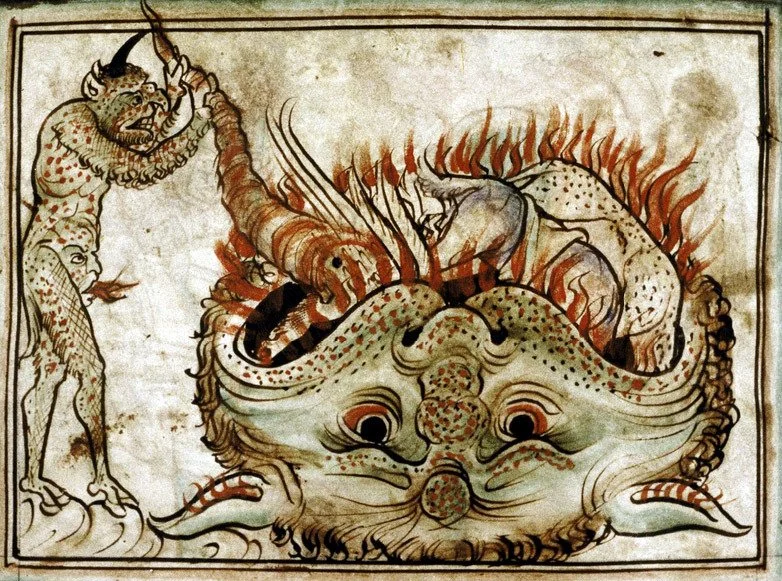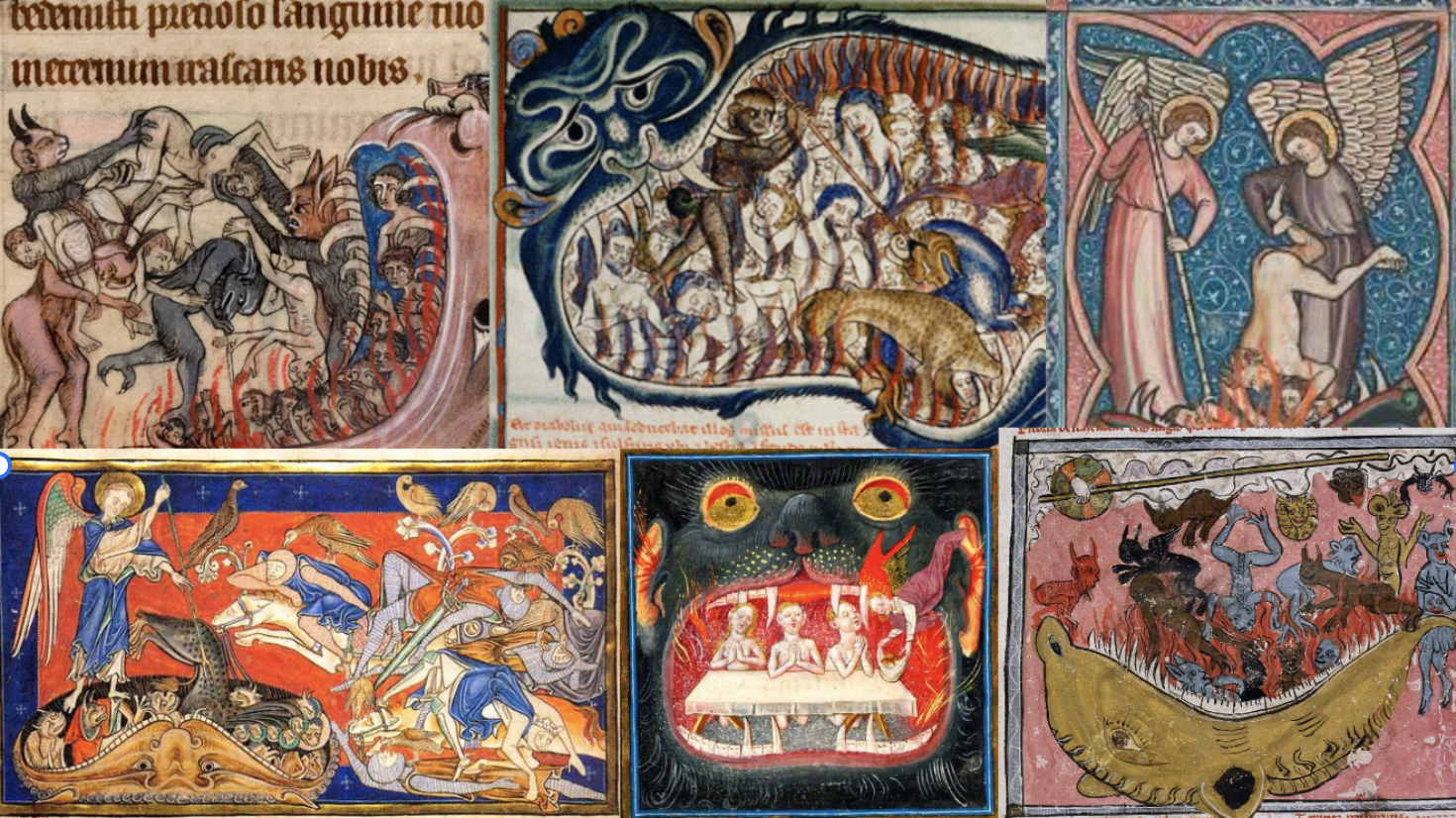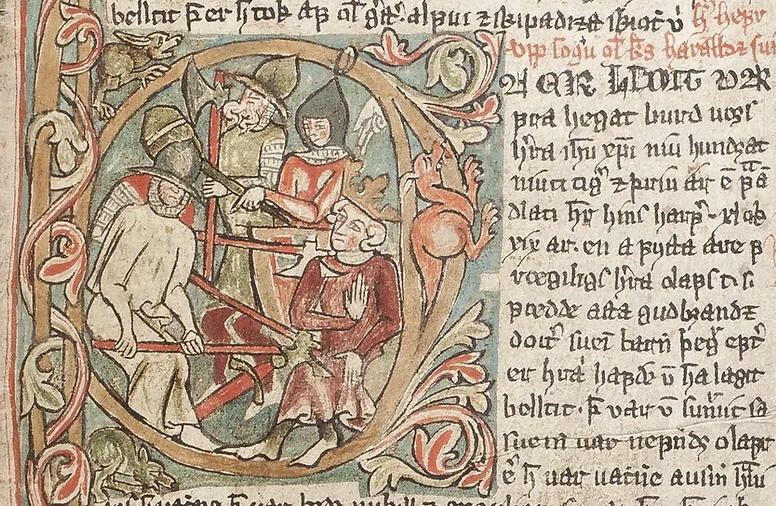Medieval Body: Mouth
The Mouth of Hell
MS Tanner 184, 13th c.
The image above is a hellmouth. A demon stirs the cauldron of living creatures into the mouth of the devil himself. Replete with flames, hair, and pustules, the devil's mouth is a decidedly gross place to end up.
Hellmouths are a visual staple in medieval manuscripts; they are meant to inspire dread and act as a warning - hey, if you sin you'll end up here. Sometimes we see angels stuffing sinners into hellmouths, other times we can see sinners dining at a table within the mouth of hell. Animals and humans - no one is spared. This enduring image uses the mouth as the central feature of its terror. In many ways it asks the viewer to consider what they themselves have put in their mouth - connecting the sins of swearing, drinking, gluttony, and sex into one gigantic maw of death.
Compilation of several medieval hellmouths
This week students read the introduction to Katie Walter's book Middle English Mouths: Late Medieval Medical, Religious, and Literary Traditions (2018), which outlines the argument for her monograph. Walters suggests that the mouth symbolizes the relationship of knowledge to salvation. While eating and drinking reflect Mikhail Bakhtin's "grotesque" they are also "manifestations of the body at its most human" (4). What is clear about the mouth is its almost portal-like modes. Walters writes
"As the entranceway into the body, the mouth's role in judging what - and how much - enters into it is crucial to physiological health, as well as to ethical status." (16)
The mouth adopts many of the other five senses in its functions: eating involves touch and smell just as much as taste. For the medieval body, the mouth was the conduit for understanding the world in the most intimate way - through consumption. Walters suggests that this type of knowledge production associated the mouth with reason and learning. But because the mouth connected both physically and spiritually to the anus through the intestinal tract, it was also understood as a corruptible part of a larger whole.
Ólafur Trygvasson in Flateyjarbók, GKS 1005 f.79r
The slippage between mouth and anus was a common didactic tool in medieval religious literature as well as a source of humor for many medieval authors. In Sin and Filth in Medieval Culture: The Devil in the Latrine (2013) Martha Bayless argues that "the anus is a sinful correlate to the mouth" (80) in medieval culture, so much so that we often find the devil's mouth as an open latrine. For instance, in an Old Icelandic text called Þorsteins þáttur skelks "The Tale of Thorstein Shiver," we learn how Thorstein Thorkelsson earned his nickname skelks, "shiver". Told not to go out to the latrine alone by none other than King Ólafur Tryggvason, Thorstein gets up one night and goes out to the bathroom. There he is met with a demon in the latrine. Knowing that he has some time to sit on the john, Thorstein engages the demon in conversation asking "Who fares best in hell?" (Hverjir þola best píslir í helvíti?), to which the demon replies Sigurður Fáfnisbani, the famed hero of Völsungasaga. Still interested, Thorstein asks "Who fares the worst?" (eða hver þolir þar verst píslir?), to which the demon replies Starkaður the Old. He cries the loudest in hell because he is submerged head first up to his ankles in fire. Finding this fascinating, Thorstein begs the demon to re-enact Starkaður's hellish cries three times. With each demonic cry, Thorstein tries to buffer the sound by wrapping cloth around his head, but he continues to faint. With the third and final cry, a church bell rings out and the demon flees. The meeting of the fiend in the latrine gets Thorstein the nickname "shiver" since he wasn't afraid but did "shiver once." The various openings of the latrine, the anus, the screaming Starkaður, and the conversational demon all collapse under the image of the mouth.
Instead of a latrine demon, students read Geoffrey Chaucer's The Pardoner's Prologue and Tale. At first glance this pilgrim and his story may not conjure up images of the mouth, but in fact the Pardoner is filled with holes. The Pardoner is a preacher and his office as a pardoner was backed by the papacy. Essentially, pardoners would travel around and take payment for pardons which were used as a remittance of purgatorial punishment. You can imagine how easily this office was corrupted. Chaucer leans into the avarice of pardoners by styling his own Pardoner as a fraudulent thief, a preacher who talks big, showcases his relics, draws his listeners into holy affections, and has them pay up.
So why the mouth? First, the Pardoner is a tale-teller in Chaucer's Canterbury Tales, he opens his mouth wide to tell the tale of his corrupt office. In his role as preacher, the Pardoner's activities are reliant upon his mouth:
344 And in Latyn I speke a wordes fewe,
And in Latin I speak a few words,
345 To saffron with my predicacioun,
With which to add spice to my preaching,
346 And for to stire hem to devocioun.
And to stir them to devotion.
347 Thanne shewe I forth my longe cristal stones,
Then I show forth my long crystal stones,
348 Ycrammed ful of cloutes and of bones --
Crammed full of rags and of bones --
349 Relikes been they, as wenen they echoon.
Relics they are, as suppose they each one.
As if he is fixing up a pot of stew, the Pardoner stirs up devotion in his listeners, adding "saffron" - some spice - to his preaching. We are to understand that the Pardoner is fraudulent - he passes off fabricated junk as holy relics, cramming the insides of bones and stones with rags. He preaches under one theme ("My theme is alwey oon, and evere was" l. 333), which is radix malorum est cupiditas "greed is the root of all evil" from 1 Timothy 6.
The Pardoner's Prologue recounts his methodology as a preacher/pardoner - he incites sinners to buy his relics for a chance at spiritual and sometimes physical healing. All that he collects he stashes in his "walet" / "purs" which we learn from the General Prologue of the Canterbury Tales is "brimming". In my article "Ycrammed ful of cloutes and of bones: Chaucer's Queer Cavities," I argue that the Pardoner's body carries many mouths and openings; he acts in some ways like a cache, a place to stash away hidden things, but also as a site of transformative potential. As students work through the Pardoner's many parts - his description in the General Prologue, his own Prologue, and finally his Tale - we will attend to the various openings and apertures that the Pardoner encourages us to creep into for a price.



